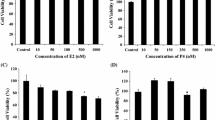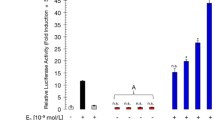Abstract
Farnesoid X receptor (FXR) is a metabolic nuclear receptor expressed in the liver and traditionally considered as a bile acid sensor. Yet, FXR has been recently demonstrated in other tissues and cells, such as the kidneys, the adrenals, and arterial smooth muscle cells. Immunohistochemical data reported in this study point to the expression of FXR in human breast cancer. In addition, FXR expression was also found by Western blotting and immunofluorescence microscopy in breast-cancer-derived cell lines MCF-7 (estrogen receptor [ER]-positive) and MDA-MB-231 (ER-negative). The FXR activator farnesol, a mevalonate pathway intermediate, exerts a mitogenic effect on MCF-7 cells. The growth stimulation is completely suppressed by antiestrogens. In contrast, MDA-MB-231 cells appear farnesol-insensitive, suggesting an involvement of ER in farnesol mitogenicity. In accordance with this interpretation, farnesol induces in MCF-7 cells a decrease of ER level, consistent with a phenomenon of receptor downregulation. Farnesol also increases progesterone receptor (PgR) expression in MCF-7 cells and stimulates ER-mediated gene transactivation in MVLN cells (MCF-7 cells stably transfected with an ER reporter gene). Of note, both effects of farnesol on ER expression and activity are completely suppressed by antiestrogens. In addition, farnesol-induced PgR is markedly reduced by FXR gene silencing (siRNA), demonstrating the involvement of FXR in the estrogenic effects of farnesol. Finally, coimmunoprecipitation experiments (FXR immunoprecipitation followed by Western blot analysis of ER in the immunoprecipitate) produced definite evidence that FXR interacts with ER. Altogether, these observations reveal the hitherto unreported presence of FXR in breast cancer and show that the latter receptor functionally interacts with ER. The occurrence of such a crosstalk calls for some caution regarding the pharmacological use of FXR agonists.







Similar content being viewed by others
References
Dumitrescu RG, Cotarla I (2005) Understanding breast cancer risk—where do we stand in 2005? J Cell Mol Med 9(1):208–221
Jensen EV, Jordan VC (2003) The estrogen receptor: a model for molecular medicine. Clin Cancer Res 9(6):1980–1989
Singh RR, Kumar R (2005) Steroid hormone receptor signaling in tumorigenesis. J Cell Biochem 96(3):490–505
Althuis MD, Fergenbaum JH, Garcia-Closas M, Brinton LA, Madigan MP, Sherman ME (2004) Etiology of hormone receptor-defined breast cancer: a systematic review of the literature. Cancer Epidemiol Biomarkers Prev 13(10):1558–1568
Jordan VC (2004) Selective estrogen receptor modulation: concept and consequences in cancer. Cancer Cell 5(3):207–213
Geisler J, Lonning PE (2005) Aromatase inhibition: translation into a successful therapeutic approach. Clin Cancer Res 11(8):2809–2821
Gronemeyer H, Gustafsson JA, Laudet V (2004) Principles for modulation of the nuclear receptor superfamily. Nat Rev Drug Discov 3(11):950–964
Driggers PH, Segars JH (2002) Estrogen action and cytoplasmic signaling pathways. Part II. The role of growth factors and phosphorylation in estrogen signaling. Trends Endocrinol Metab 13(10):422–427
Ohtake F, Takeyama K, Matsumoto T, Kitagawa H, Yamamoto Y, Nohara K, Tohyama C, Krust A, Mimura J, Chambon P et al (2003) Modulation of oestrogen receptor signalling by association with the activated dioxin receptor. Nature 423(6939):545–550
Clarke RB, Anderson E, Howell A (2004) Steroid receptors in human breast cancer. Trends Endocrinol Metab 15(7):316–323
Francis GA, Fayard E, Picard F, Auwerx J (2003) Nuclear receptors and the control of metabolism. Annu Rev Physiol 65:261–311
Forman BM, Goode E, Chen J, Oro AE, Bradley DJ, Perlmann T, Noonan DJ, Burka LT, McMorris T, Lamph WW et al (1995) Identification of a nuclear receptor that is activated by farnesol metabolites. Cell 81(5):687–693
Nishimaki-Mogami T, Une M, Fujino T, Sato Y, Tamehiro N, Kawahara Y, Shudo K, Inoue K (2004) Identification of intermediates in the bile acid synthetic pathway as ligands for the farnesoid X receptor. J Lipid Res 45(8):1538–1545
Makishima M (2005) Nuclear receptors as targets for drug development: regulation of cholesterol and bile acid metabolism by nuclear receptors. J Pharmacol Sci 97(2):177–183
Rogers MJ (2003) New insights into the molecular mechanisms of action of bisphosphonates. Curr Pharm Des 9(32):2643–2658
Body JJ (2006) Bisphosphonates for malignancy-related bone disease: current status, future developments. Support Care Cancer 14(5):408–418
Allred DC, Harvey JM, Berardo M, Clark GM (1998) Prognostic and predictive factors in breast cancer by immunohistochemical analysis. Mod Pathol 11(2):155–168
Demirpence E, Duchesne MJ, Badia E, Gagne D, Pons M (1993) MVLN cells: a bioluminescent MCE-7-derived cell line to study the modulation of estrogenic activity. J Steroid Biochem Mol Biol 46(3):355–364
Devleeschouwer N, Legros N, Olea-Serrano N, Paridaens R, Leclercq G (1987) Estrogen conjugates and serum factors mediating the estrogenic trophic effect on MCF-7 cell growth. Cancer Res 47(22):5883–5887
Journe F, Body JJ, Leclercq G, Nonclercq D, Laurent G (2004) Estrogen responsiveness of IBEP-2, a new human cell line derived from breast carcinoma. Breast Cancer Res Treat 86(1):39–53
Brohee R, Nonclercq D, Journe DN, Toubeau G, Falmagne P, Leclercq G, Heuson-Stiennon JA, Laurent G (2000) Demonstration of estrogen receptors and of estrogen responsiveness in the HKT-1097 cell line derived from diethylstilbestrol-induced kidney tumors. In Vitro Cell Dev Biol Anim 36(10):640–649
Lee MV, Fong EM, Singer FR, Guenette RS (2001) Bisphosphonate treatment inhibits the growth of prostate cancer cells. Cancer Res 61(6):2602–2608
Bauer DC (2003) HMG CoA reductase inhibitors and the skeleton: a comprehensive review. Osteoporos Int 14(4):273–282
Swales KE, Korbonits M, Carpenter R, Walsh DT, Warner TD, Bishop-Bailey D (2006) The farnesoid X receptor is expressed in breast cancer and regulates apoptosis and aromatase expression. Cancer Res 66(20):10120–10126
Silva J, Dasgupta S, Wang G, Krishnamurthy K, Ritter E, Bieberich E (2006) Lipids isolated from bone induce the migration of human breast cancer cells. J Lipid Res 47(4):724–733
Lange CA, Shen T, Horwitz KB (2000) Phosphorylation of human progesterone receptors at serine-294 by mitogen-activated protein kinase signals their degradation by the 26S proteasome. Proc Natl Acad Sci USA 97(3):1032–1037
Lew JL, Zhao A, Yu J, Huang L, De Pedro N, Pelaez F, Wright SD, Cui J (2004) The farnesoid X receptor controls gene expression in a ligand- and promoter-selective fashion. J Biol Chem 279(10):8856–8861
Davies GF, McFie PJ, Khandelwal RL, Roesler WJ (2002) Unique ability of troglitazone to up-regulate peroxisome proliferator-activated receptor-gamma expression in hepatocytes. J Pharmacol Exp Ther 300(1):72–77
Habeos I, Ziros PG, Psyrogiannis A, Vagenakis AG, Papavassiliou AG (2005) Statins and transcriptional regulation: the FXR connection. Biochem Biophys Res Commun 334(2):601–605
Leclercq G, Lacroix M, Laios I, Laurent G (2006) Estrogen receptor alpha: impact of ligands on intracellular shuttling and turnover rate in breast cancer cells. Curr Cancer Drug Targets 6(1):39–64
Baker PR, Wilton JC, Jones CE, Stenzel DJ, Watson N, Smith GJ (1992) Bile acids influence the growth, oestrogen receptor and oestrogen-regulated proteins of MCF-7 human breast cancer cells. Br J Cancer 65(4):566–572
Safe S, Wormke M, Samudio I (2000) Mechanisms of inhibitory aryl hydrocarbon receptor-estrogen receptor crosstalk in human breast cancer cells. J Mammary Gland Biol Neoplasia 5(3):295–306
Wormke M, Stoner M, Saville B, Safe S (2000) Crosstalk between estrogen receptor alpha and the aryl hydrocarbon receptor in breast cancer cells involves unidirectional activation of proteasomes. FEBS Lett 478(1–2):109–112
Wormke M, Stoner M, Saville B, Walker K, Abdelrahim M, Burghardt R, Safe S (2003) The aryl hydrocarbon receptor mediates degradation of estrogen receptor alpha through activation of proteasomes. Mol Cell Biol 23(6):1843–1855
Pollenz RS (2002) The mechanism of AH receptor protein down-regulation (degradation) and its impact on AH receptor-mediated gene regulation. Chem Biol Interact 141(1–2):41–61
Costarelli V, Sanders TA (2002) Plasma deoxycholic acid concentration is elevated in postmenopausal women with newly diagnosed breast cancer. Eur J Clin Nutr 56(9):925–927
Raju U, Levitz M, Javitt NB (1990) Bile acids in human breast cyst fluid: the identification of lithocholic acid. J Clin Endocrinol Metab 70(4):1030–1034
Javitt NB, Budai K, Miller DG, Cahan AC, Raju U, Levitz M (1994) Breast-gut connection: origin of chenodeoxycholic acid in breast cyst fluid. Lancet 343(8898):633–635
Costarelli V, Sanders TA (2002) Plasma bile acids and risk of breast cancer. IARC Sci Publ 156:305–306
Zhang Y, Lee FY, Barrera G, Lee H, Vales C, Gonzalez FJ, Willson TM, Edwards PA (2006) Activation of the nuclear receptor FXR improves hyperglycemia and hyperlipidemia in diabetic mice. Proc Natl Acad Sci USA 103(4):1006–1011
Claudel T, Sturm E, Kuipers F, Staels B (2004) The farnesoid X receptor: a novel drug target? Expert Opin Investig Drugs 13(9):1135–1148
Pellicciari R, Costantino G, Fiorucci S (2005) Farnesoid X receptor: from structure to potential clinical applications. J Med Chem 48(17):5383–5403
Bishop-Bailey D (2004) FXR as a novel therapeutic target for vascular disease. Drug News Perspect 17(8):499–504
Acknowledgments
This study received financial support from the Fondation Medic, from Hoffmann-LaRoche (Basel, Switzerland), from the Fondation contre le Cancer, from the Belgian Fund for Medical Scientific Research (grants no. 3.4563.02 and 3.4512.03), and from Les Amis de l’Institut Bordet. Guy Laurent is Senior Research Associate of the National Fund for Scientific Research (Belgium).
Author information
Authors and Affiliations
Corresponding author
Additional information
Fabrice Journe and Guy Laurent contributed equally to this work and should be considered as joint first authors.
Rights and permissions
About this article
Cite this article
Journe, F., Laurent, G., Chaboteaux, C. et al. Farnesol, a mevalonate pathway intermediate, stimulates MCF-7 breast cancer cell growth through farnesoid-X-receptor-mediated estrogen receptor activation. Breast Cancer Res Treat 107, 49–61 (2008). https://doi.org/10.1007/s10549-007-9535-6
Received:
Accepted:
Published:
Issue Date:
DOI: https://doi.org/10.1007/s10549-007-9535-6




